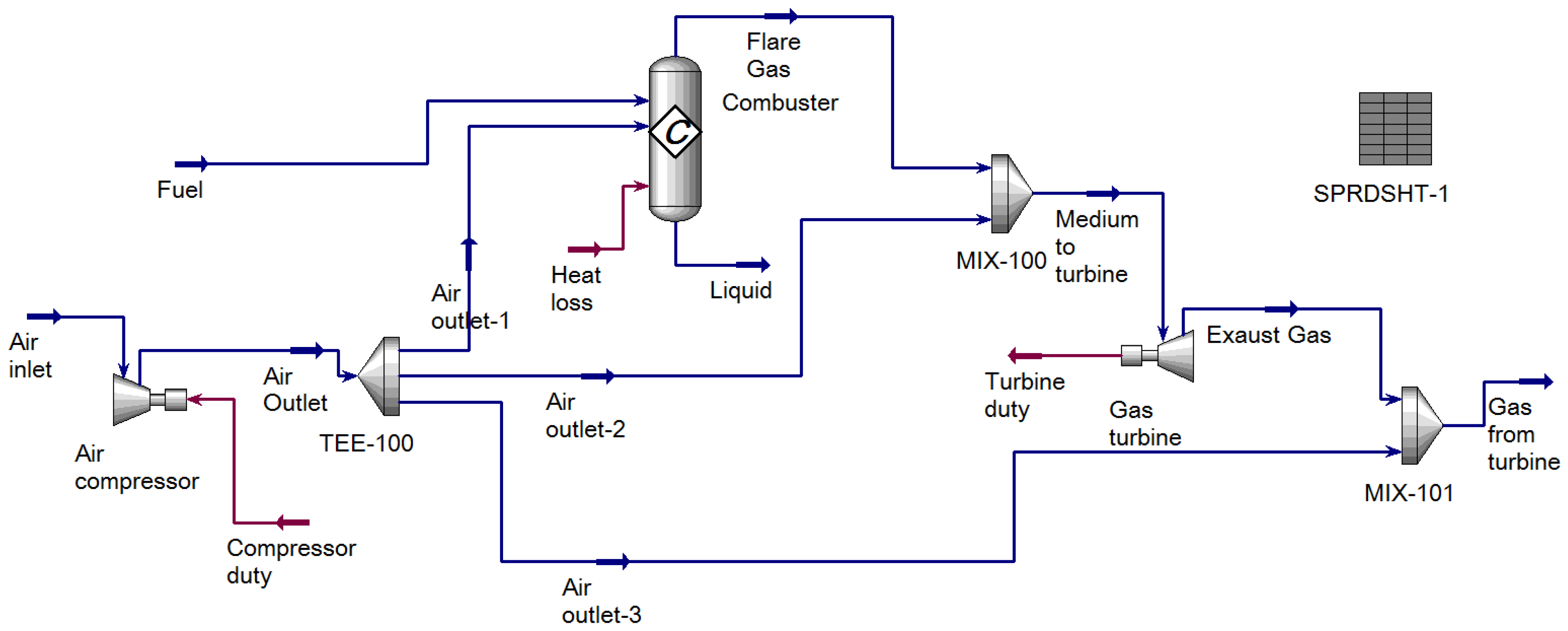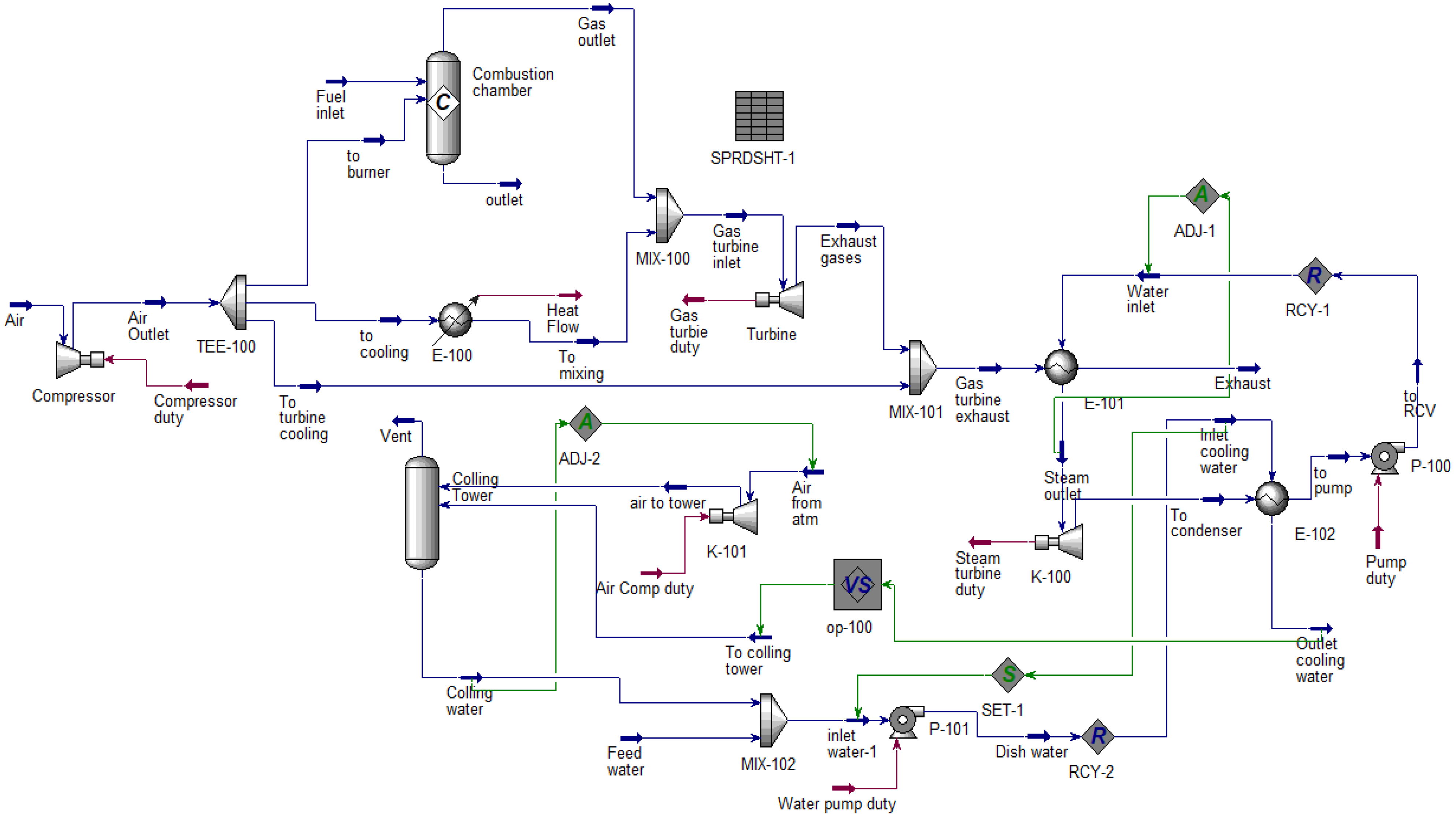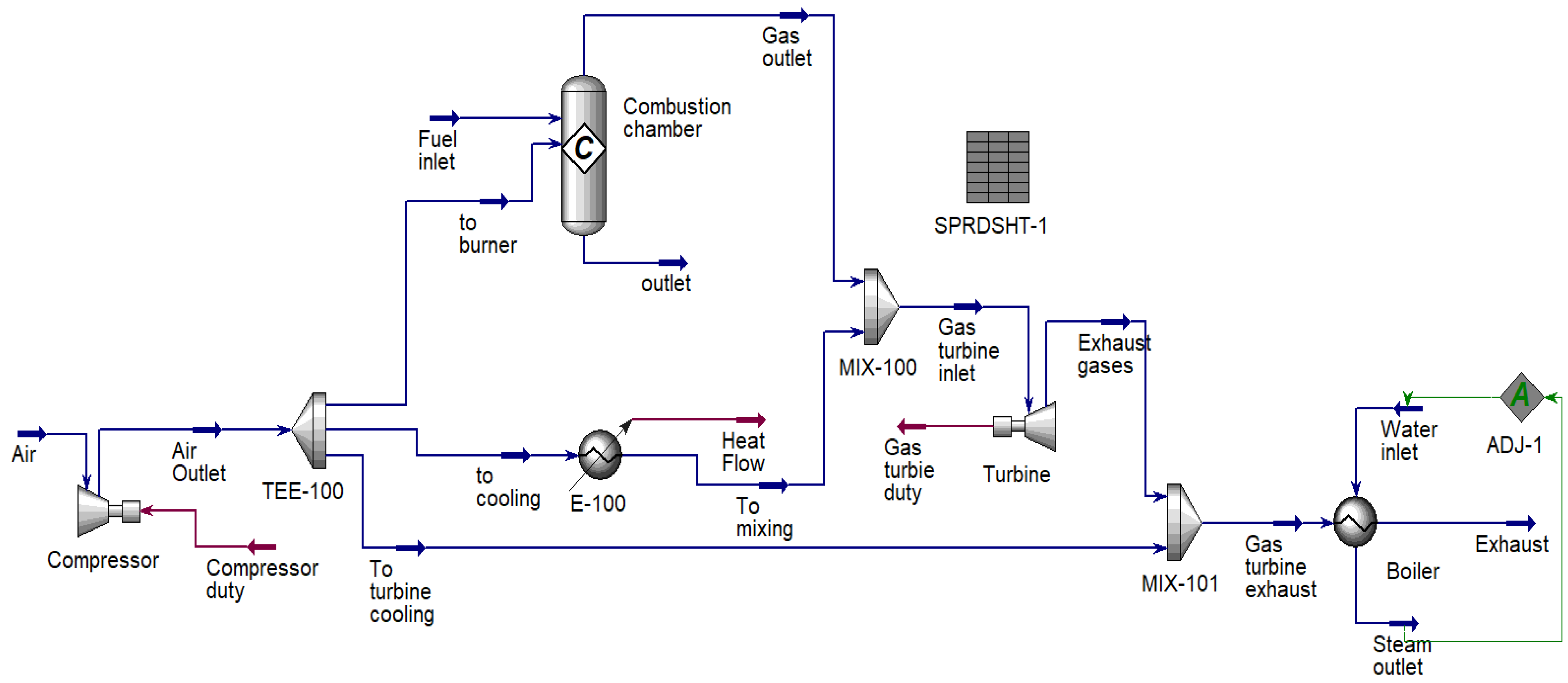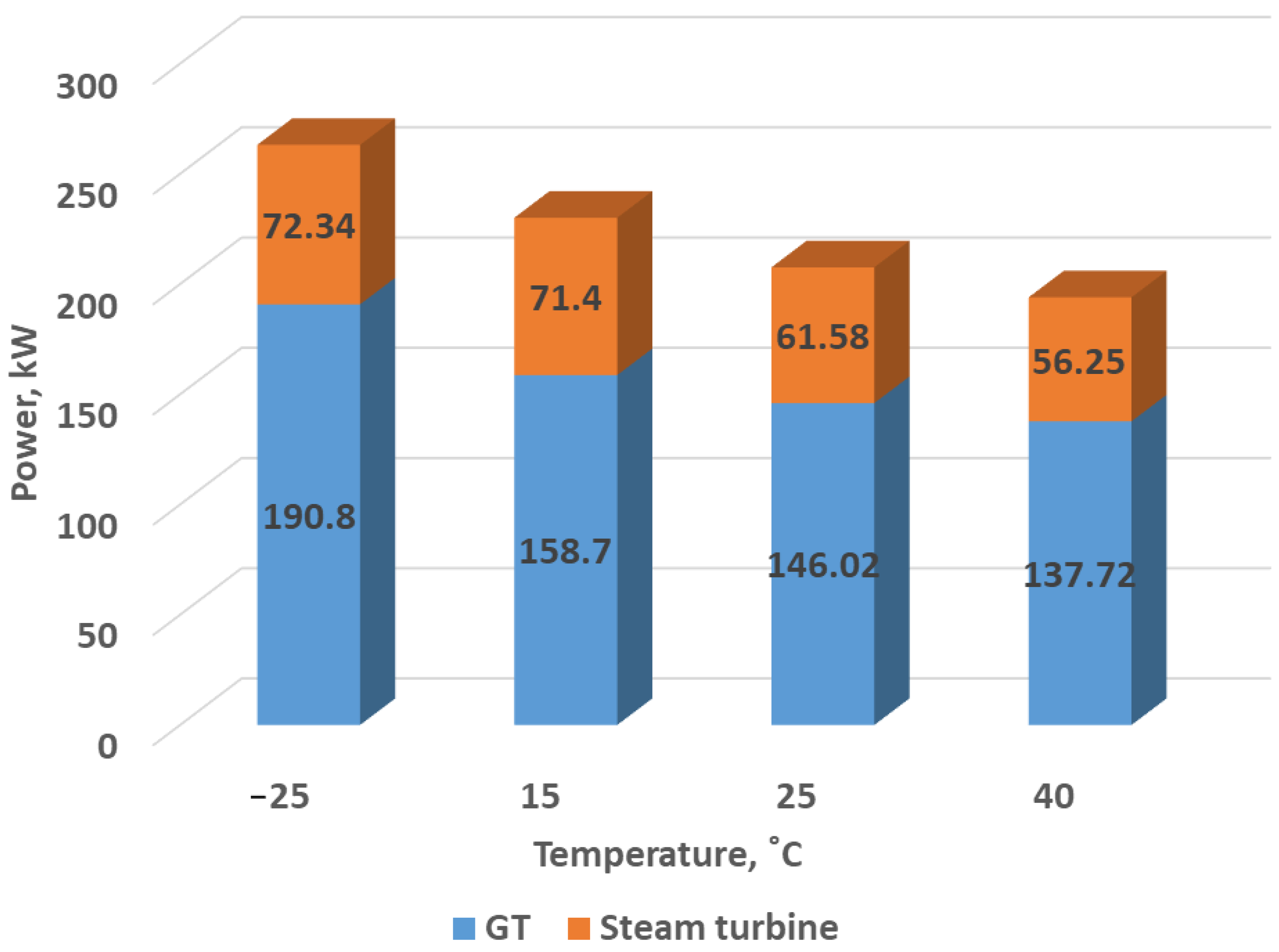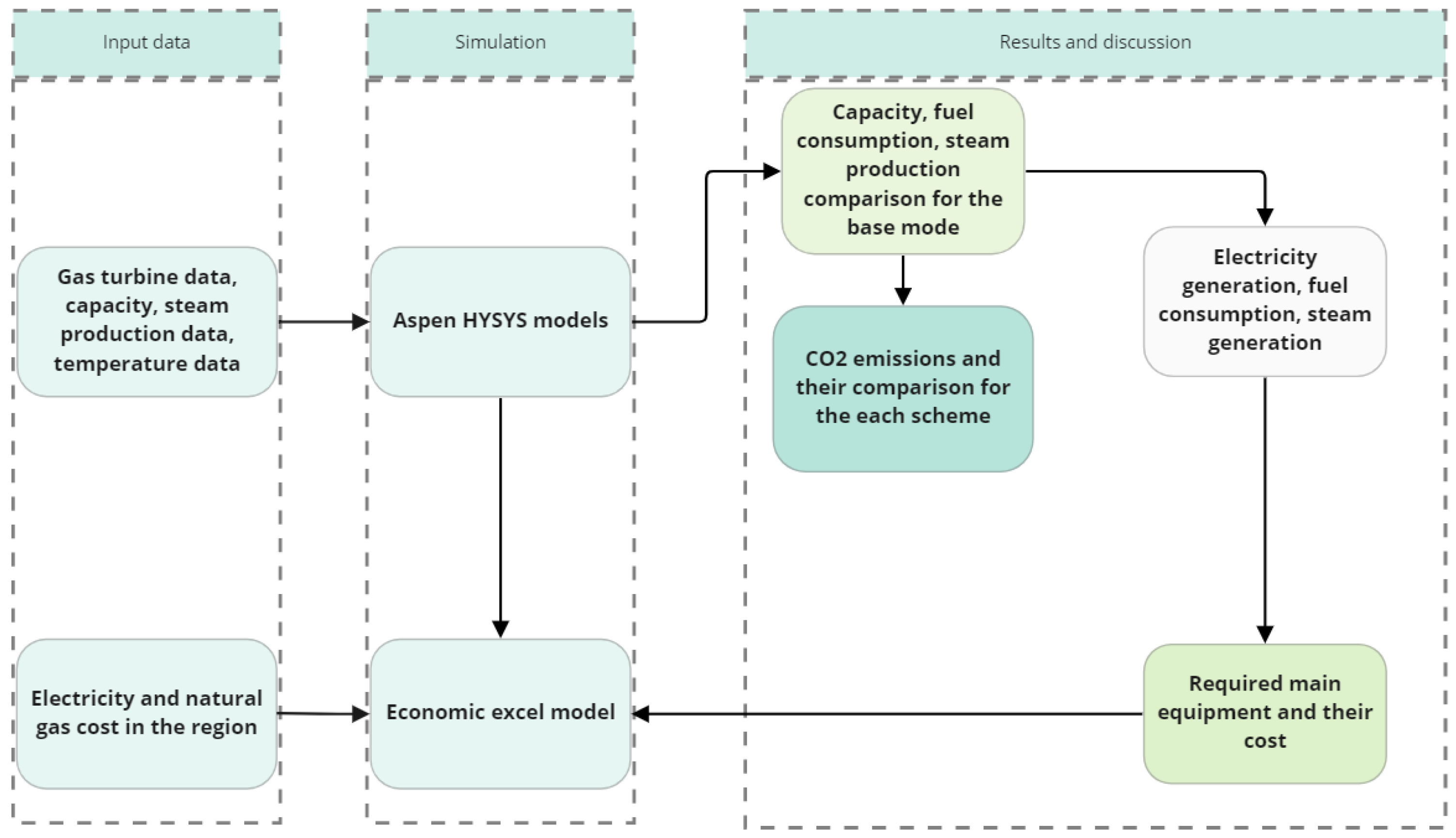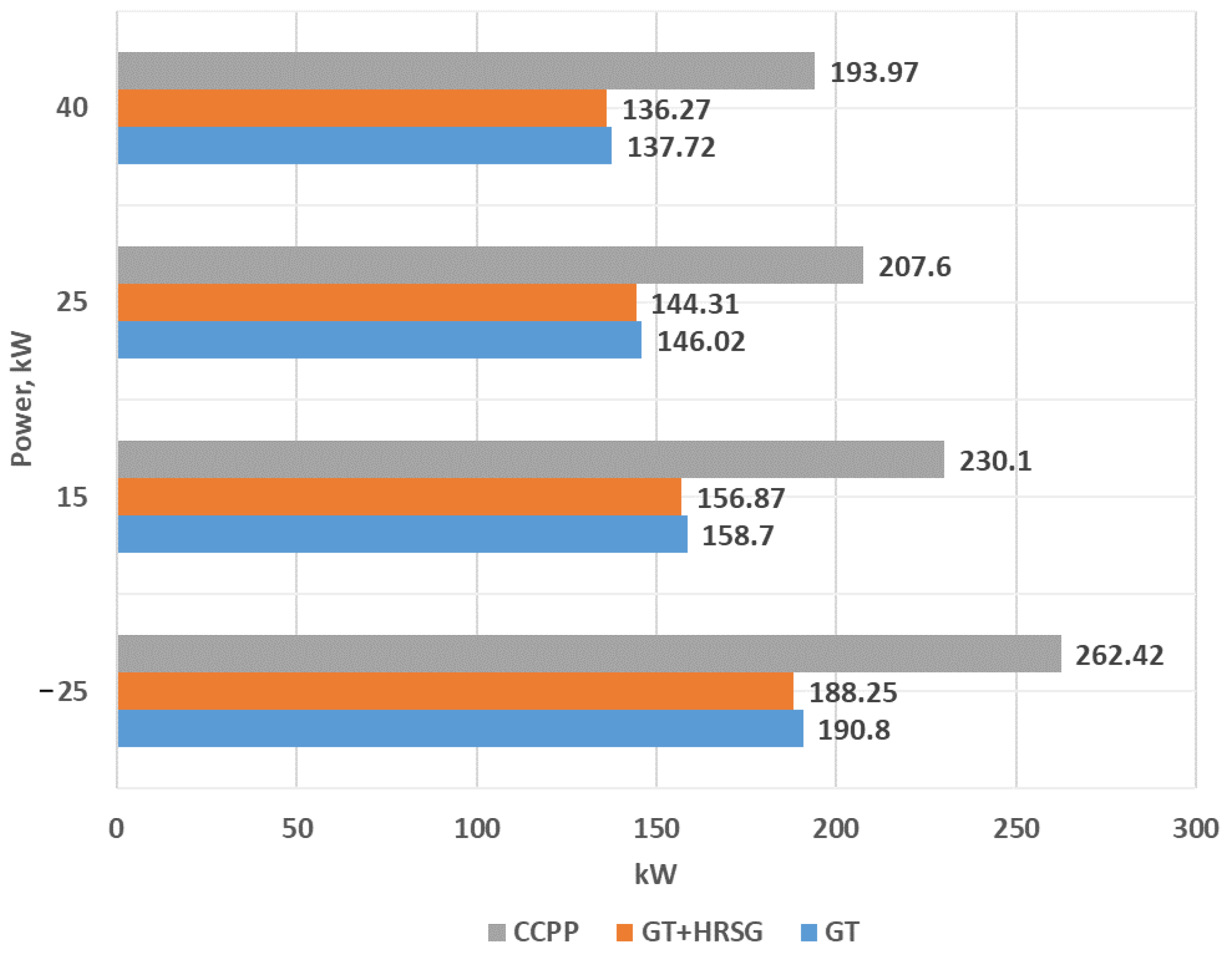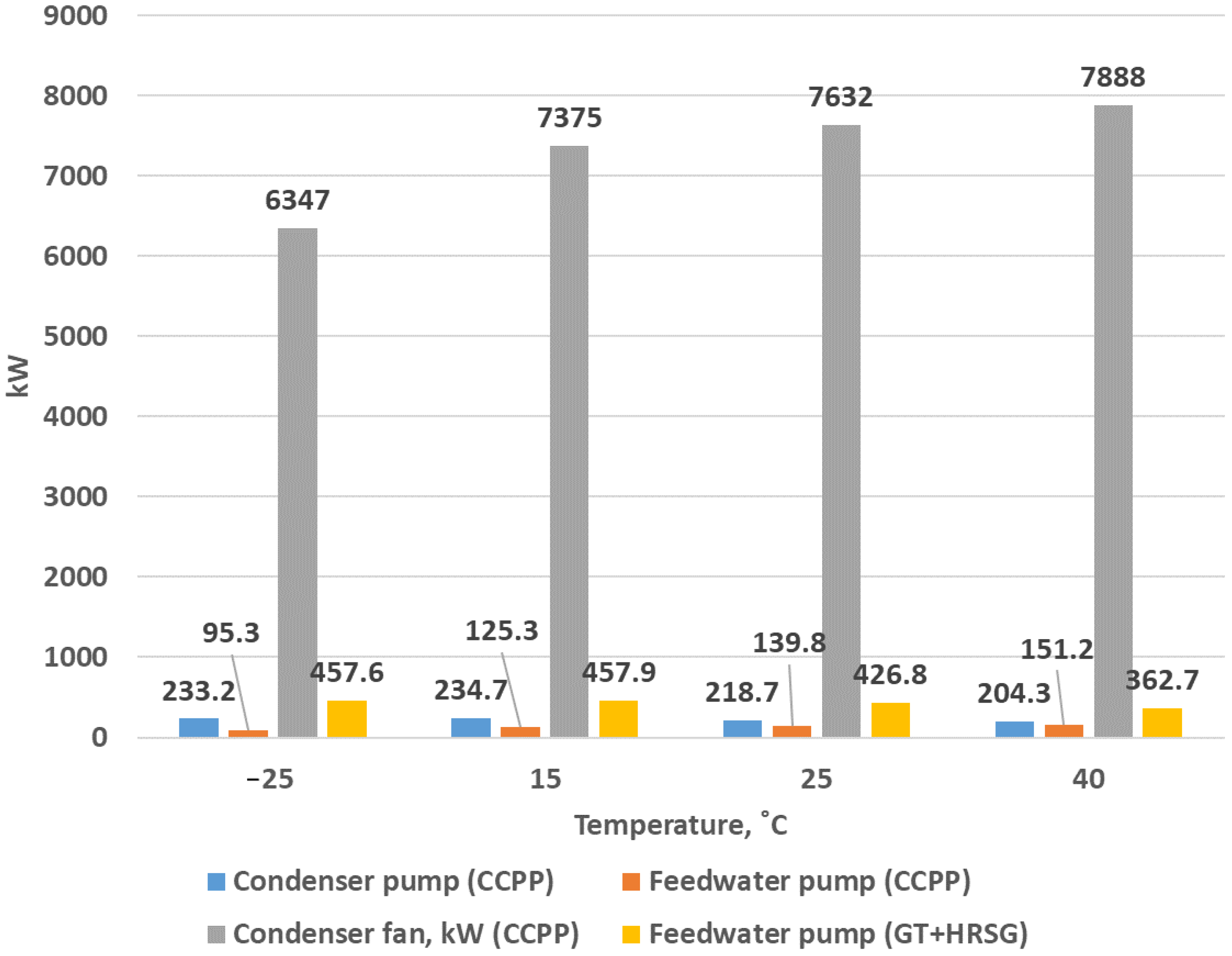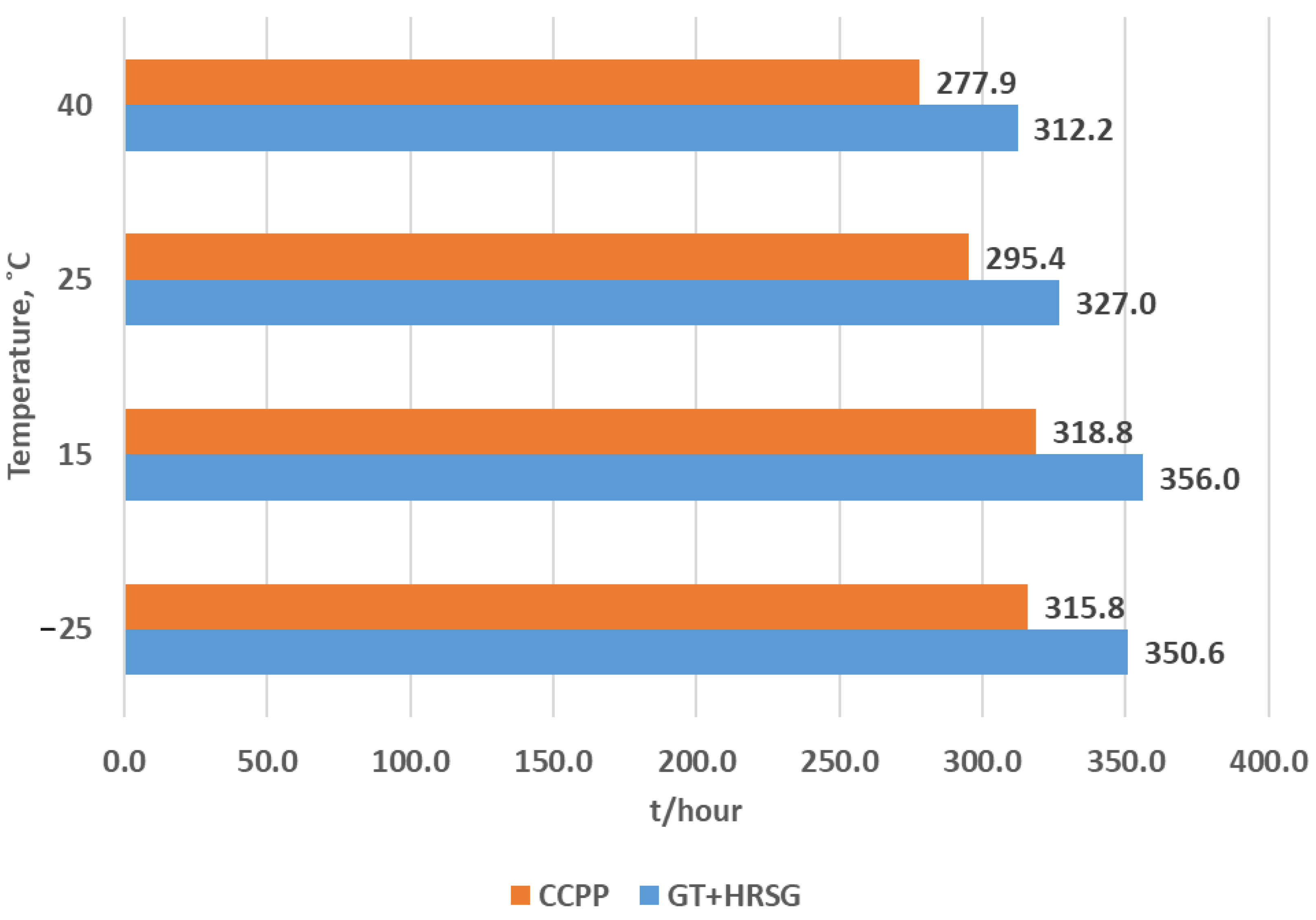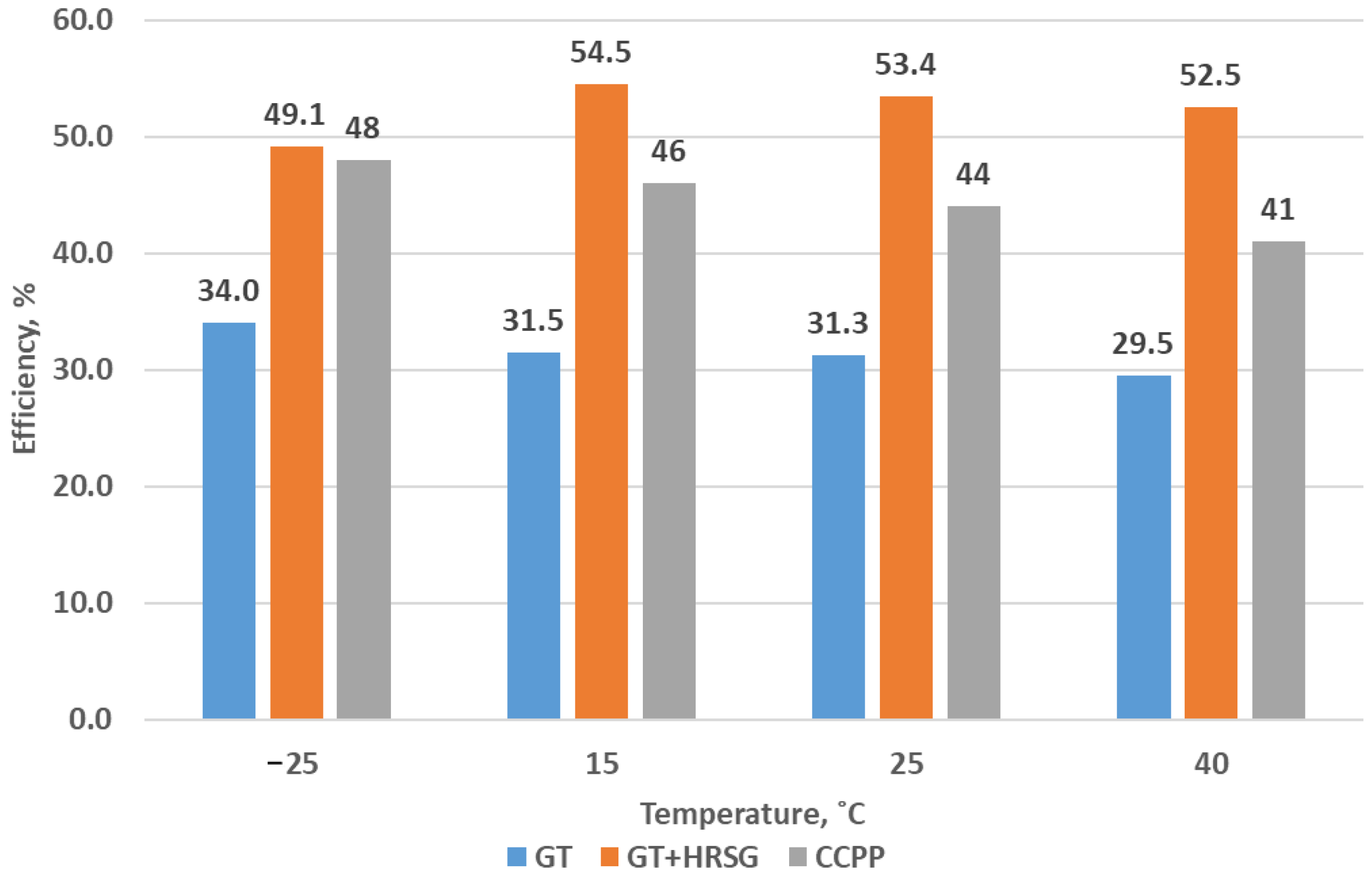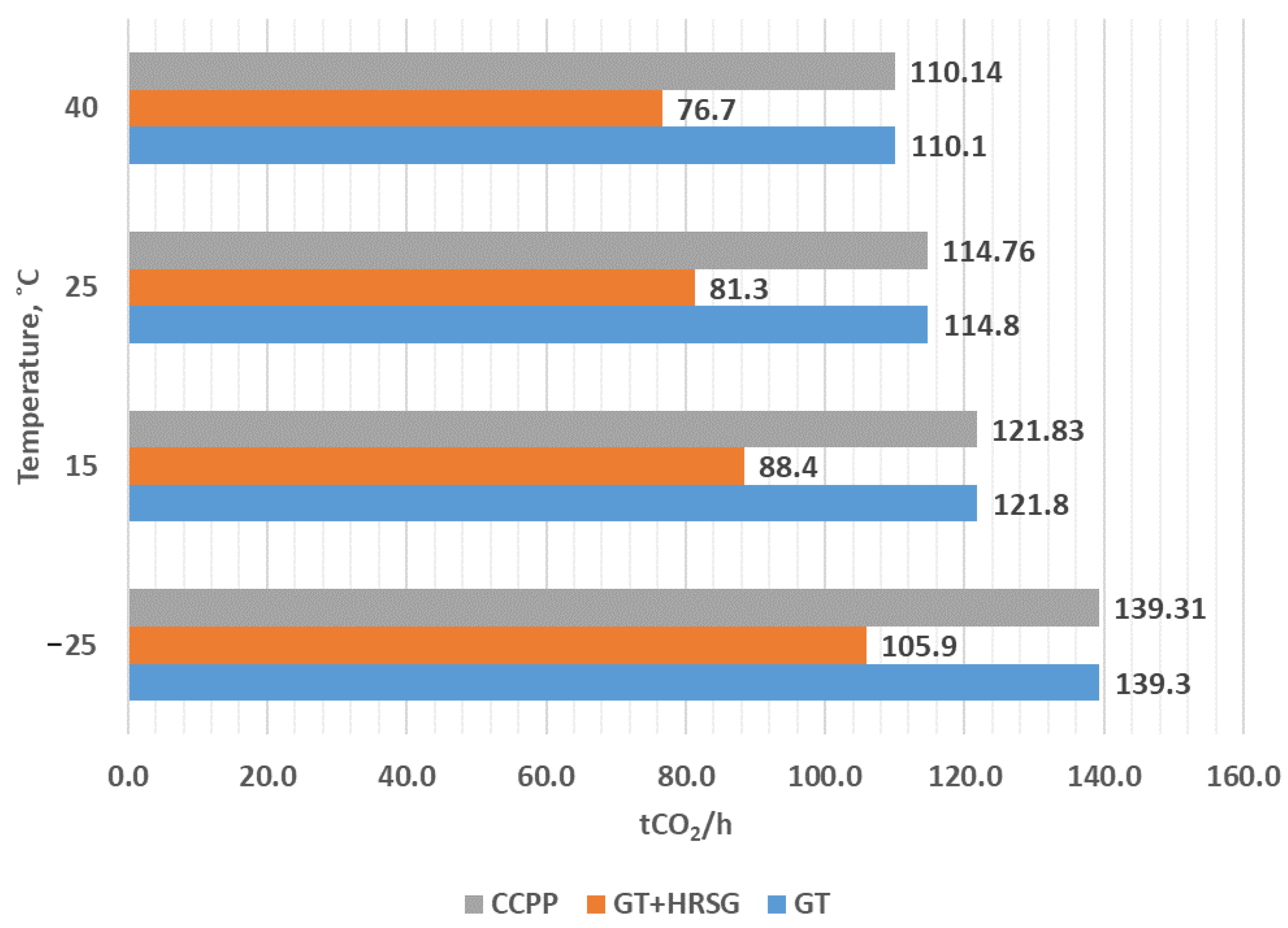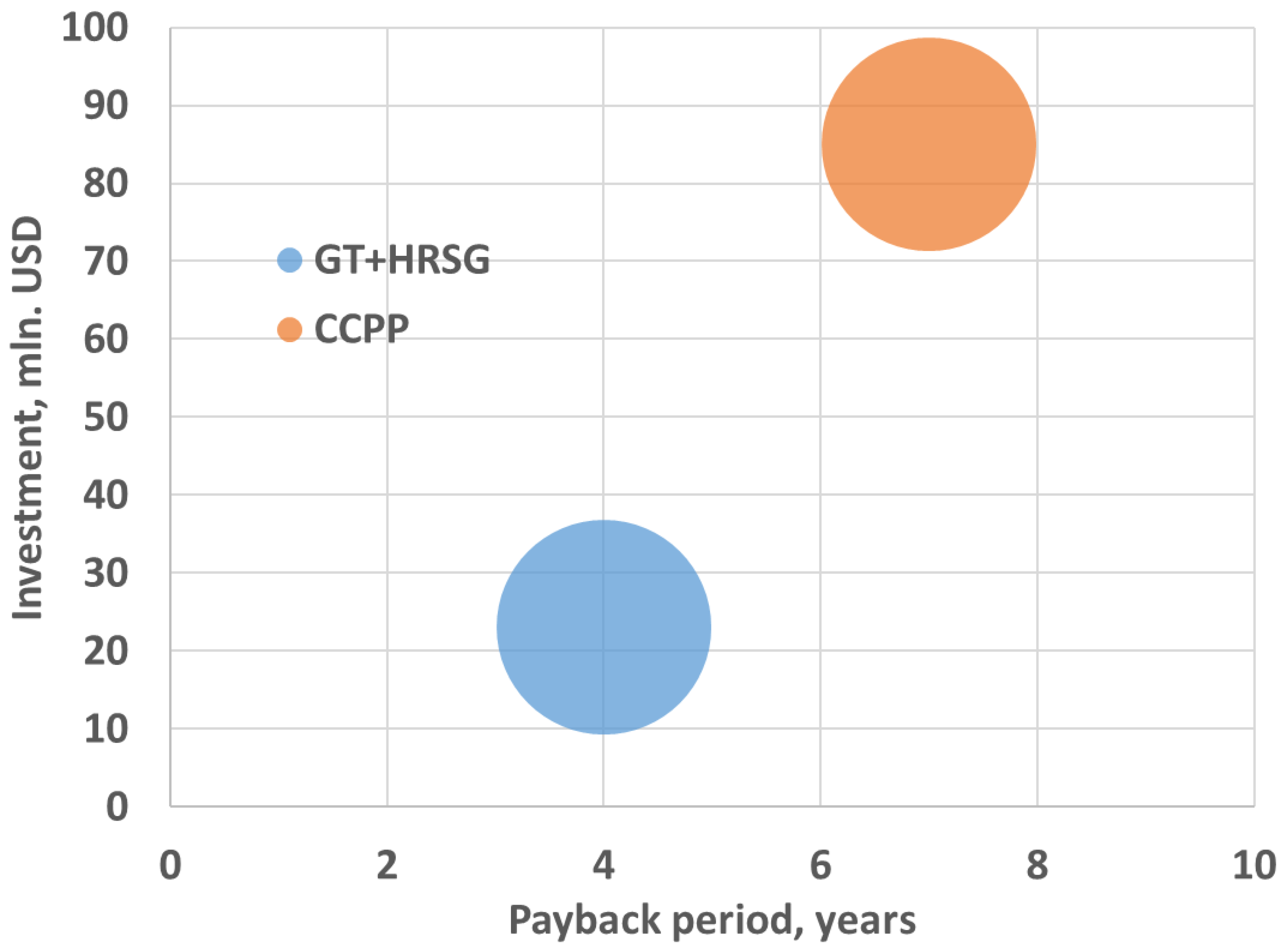Review and Analysis
Today, in Kazakhstan, as in most countries of the world, the issue of reducing greenhouse gas emissions into the environment is acute [
1,
2]. The Kyoto Protocol signed in 1997 clearly shows us that there is a need to reduce greenhouse gases, but there are a number of problems. One of the problems is the complexity of the transition from traditional fuels to clean fuels, since green technologies are currently quite expensive [
3]. Therefore, it is important to switch to traditional technologies, taking into account the relatively low cost of electricity, and as a result, the long payback period for renewable energy sources. Currently, intensive developments are underway in the field of combined cycles that allow the use of secondary heat from the main processes. For example, the work [
4] provides an analysis of the operation of the exhaust gas utilization plant using the organic Rankine cycle. The paper presents two schemes, in the first, the exhaust gases of the gas turbine cylinder heat the coolant of the ORC, i.e., generate heat, in the second they generate heat, and then electricity in the ORC. The study showed that the maximum exergetic efficiency is achieved by increasing the production of thermal energy. In [
5], an analysis of two schemes for using the combustion products of a gas turbine was carried out, in the first option, the gas was partially fed into the recuperator to heat the air in front of the combustion chamber, in the second, the gas was completely supplied to the boiler utilizer. The first option showed an increase of 1.7% from the base option. In [
6], a thermodynamic analysis of the operation of a combined cycle based on ultrahigh pressure carbon dioxide was carried out. In this scheme, the exhaust gases of the GTU in the utilizer are heated with CO
2, which is used to produce electrical energy. The use of CO
2 at supercritical parameters allows for the increase in the efficiency of the cycle by 1.4%. The paper [
7] analyzes the influence of ambient temperature on the efficiency of the combined cycle with a carbon capture system. The analysis showed a significant decrease in cycle efficiency with an increase in ambient temperature by 7–8% of the baseline value for all analyzed cycles. The paper [
8] analyzes the transformation of a steam turbine cycle into a cogeneration plant. Two options are given, the first uses absorption heat pumps, the second uses a heat exchanger. A study of the use of gaseous products for the organic Rankine cycle [
9] showed that such cycles have high efficiency. The paper [
10] presents an analysis of the use of solar collectors in a microturbine combined cycle. In [
11], an analysis of the energy analysis of the combined cycle for ORC and CO
2 utilization using Aspen Plus was carried out. The use of a modified Viburnum cycle with liquefied gas in a combined cycle allows for the achieving of an efficiency equal to 59.47% [
12]. In [
13], an analysis of the combined cycle with plasma treatment of municipal garbage for incineration was carried out. The analysis of combined cycles and combined cycle technologies shows that there is a sufficiently large potential for using the heat of the exhaust gases of gas turbine cycles.
Currently, it is important to predict the economic and environmental efficiency of the analyzed technologies [
14]. To do this, it is necessary to create a sufficiently accurate model that considers a wide range of factors affecting the operation of such an installation. In [
15], an analysis of the model of a gas turbine installation was carried out, in which the influence of the number of revolutions on the efficiency of the installation in the network was analyzed. The paper [
16] presents a model for the study of NOx emissions based on ANFIS. The paper [
17] presents a model based on artificial intelligence for the analysis of a combined cycle gas plant based on the supercritical cycle of Brighton and Rankin. This model showed a high level of accuracy. The paper [
18] presents a model for modeling combined cycles with the introduction of solar technologies. It is revealed that the off-design conditions, particularly the direct normal irradiance and the wind speed, affect the integrated solar combined cycle performance significantly.
Since the GTU installations operated at oil production and refining enterprises are operated year-round and continuously for most of the year, their improvement becomes an urgent task that allows reduction in not only the company’s costs for technological processes, but also the damage that it can cause to nature. There are various ways to improve the hardware and technological design of GTU, one of which is computer modeling of processes occurring at the main stages of the GTU cycle. For example, in [
19], the characteristics of the main GTU units (compressor and gas turbine) were generalized from production data in the form of polynomial dependencies, which were used to calculate the main indicators of the cycle and its efficiency. In [
20], a gas turbine was divided into a number of parts, each of which corresponded to a turbine stage. In [
21,
22], heat balance equations were written for each stage, on the basis of which the efficiency of the installation as a whole was calculated. In the work [
23] modeling of the GTU, the functionality of the Aspen HYSYS computer-aided design system was used, while the adequacy of the developed mathematical models was checked by comparison with the calculated values obtained in another program or data from an industrial survey of an operating installation.
In a previous study [
24], the implementation of an intermediate cooling system was analyzed as a means of enhancing the efficiency of gas turbines, resulting in a production increase of 20%. However, this technology is not fully viable under the high ambient temperatures of Kazakhstan, as additional cooling would entail substantial costs for cold production. Another study [
25] evaluated the use of a combined cycle gas turbine with a compressed air storage system, leading to improved plant reliability and maneuverability. Moreover, the application of solar panels to CCPP was investigated in [
26] using the Aspen HYSYS program.
The literature review conducted herein highlights the optimization potential, taking into account gas turbine units operating for more than 20,000 h in Kazakhstan’s specific field conditions, characterized by the absence of water sources and low electricity costs. The lack of sources for large volumes of water should be considered in any such optimization effort.
According to the Environmental Code of the Republic of Kazakhstan [
27], the State policy is based on the principles of sustainable development and energy efficiency improvement, as well as the maximum possible disposal of industrial waste. Additionally, according to the new Environmental Code adopted in January 2021, oil and natural gas production belong to the list of areas of application of the best available techniques. The typical list of environmental protection measures includes the introduction of measures aimed at reducing greenhouse gas emissions, as well as measures for the installation of equipment that allows for an increase in energy efficiency. According to the strategy for the transition to a green economy [
28], it is necessary to switch everywhere to gas for the production of electric energy, taking into account the finite renewable energy sources. According to [
29] the concept of development of the fuel and energy complex of the Republic of Kazakhstan, the oil industry is one of the most important sectors of the economy, the basic exporting industry, which allows the country to capitalize its own mineral resources and receive sufficient capital inflows for the accelerated development of the industrial complex. The Republic of Kazakhstan is one of the key sources of hydrocarbon raw materials for the world economy. As of 2013, Kazakhstan ranks 12th in the world in terms of proven oil reserves; 7% of all oil produced in the Republic is produced in the West Kazakhstan region. This article discusses the oil field located in the West Kazakhstan region of the Republic of Kazakhstan. The Karachaganak field, discovered in 1979, is one of the world’s largest gas and condensate fields. Located in north-west Kazakhstan and covering an area of over 280 square kilometres, it holds estimated hydrocarbons initially in place (HIIP) of 9 billion barrels of condensate and 48 trillion cubic feet (tcf) of gas, with estimated gross reserves of over 2.4 billion barrels of condensate and 16 tcf of gas. In 2021, the volume of hydrocarbon production at the enterprise reached 134.05 million barrels of oil equivalent [
30]. Therefore, two schemes are considered as recommendations in this work: a combined cycle gas installation and the use of exhaust gases to produce high-pressure steam for the needs of the plant.
The development of solutions aimed at reducing operating costs for an oil company is certainly an urgent task aimed not only at reducing monetary costs, but also at the rational use of available energy resources. The use of extracted associated gas as fuel for generating steam and electricity can be a rational solution that allows not only for reducing the unit costs for oil production, but also to significantly reduce the environmental damage caused. Determining the design layout of equipment for generating steam and electricity for the needs of the plant is one of the main factors affecting the profitability. The choice of one or another scheme depends on the forecast calculations of the expected oil production. With low oil production, the cost of steam generators and diesel generators for electricity production is not so significant in the cost items for oil production and preparation. However, everything changes with a large volume of oil produced; in this case, it is most expedient to consider thermal power plants, CCPTs (combined cycle power plants), or combined-type gas turbine power plants that produce high-efficiency electricity and high-pressure steam.
In addition, it is necessary to consider the feasibility study of the project, which cannot be carried out without high-precision calculations with extensive use of modeling programs. The purpose of this work was to develop a mathematical model of the operating GTU of an oil-producing company located in the Republic of Kazakhstan, to check the adequacy of the model according to the technological survey of the installation and to develop recommendations for its improvement, to analyze the proposed schemes from the point of view of technical, environmental, and economic indicators. In addition, it is necessary to consider the feasibility study of the project, which cannot be carried out without high-precision calculations with extensive use of modeling programs.
The studied GTPP is in the oil field of the Republic of Kazakhstan and is designed to generate electrical energy necessary for the operation of technological equipment. The power output of the power plant is provided at a voltage of 110, 35, and 6 kV. At a voltage of 35 and 6 kV, it is planned to provide power to consumers of the PDA and the surrounding residential area. A general analysis of energy consumption in 2017 showed that the GTPP within the company consumes:
- ₋
Fuel gas—37.95%;
- ₋
Diesel fuel—0.29%;
- ₋
Electric energy—2.40%.
GTPP is one of the major consumers of fuel gas and has a significant impact on the energy intensity of the company. Diesel fuel consumption within the company is high; however, within the GTPP, consumption is low at 0.29%. The main energy resource is fuel gas, which is needed as fuel to produce electric energy. Diesel fuel is used in small quantities during repairs and as a backup fuel. Since the amount of diesel fuel used is very small, it is not considered as an energy resource in further analysis. The consumption of electricity for the own needs of the GTPP does not exceed 0.44% of the total consumption of energy resources.
Four power units with gas turbine drives of electric generators are installed at the gas turbine power plant (GTPP); General Electric gas turbines, four PG6561 turbines with a nominal capacity of 36.31 MW, respectively. The first three GTU were put into operation in 2001, and the fourth GTU in 2005. For single-shaft three-stage jet-type turbines, the number of compressor stages is 17. The parameters of the GTU are presented in
Table 1. There are no waste gas heat recovery systems after the GTU.
The design documentation of the power plant stipulates that in the future, a system for using the heat of exhaust gases after turbines should be introduced. One of the factors affecting the output power of turbines is the intake air temperature. When the air temperature rises, the turbine power decreases. Due to the lack of separate instrumentation on each turbine, accounting is conducted on a common gas supply line with a diameter of 200 mm. As can be seen from the data presented in
Figure 1, the average monthly capacity and average monthly output in the summer months decreases. All 4 turbines are operating during the year. The maximum efficiency of one machine is achieved in the cold months and in April–May. With an increase in ambient temperature, the average efficiency and power generation decreases; for example, if in January–March the average power of four turbines is 121.2 MW, then in April–June the average power of the station is 100.8 MW. The power reduction is 16%. This is due to an increase in air temperature, which leads to an increase in the specific work of compression in the compressor. From the graph, you can see that all four turbines operate at full load all year round, taking into account that in the summer, the turbines operate at maximum load, and electricity generation is reduced. During the summer period, electricity reserves are significantly reduced. The utilization rate of GTU is 75%, and the lowest indicators obviously fall on a period with a high temperature.
